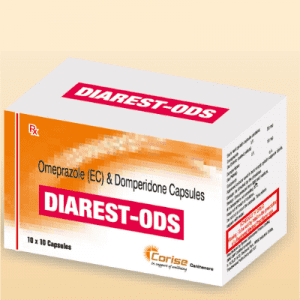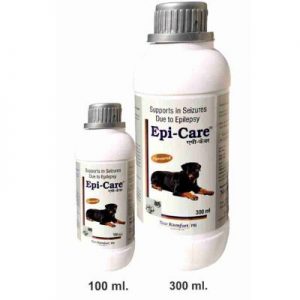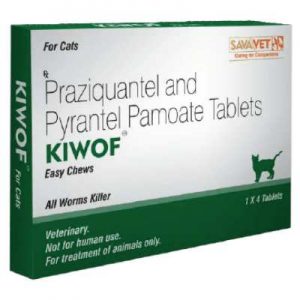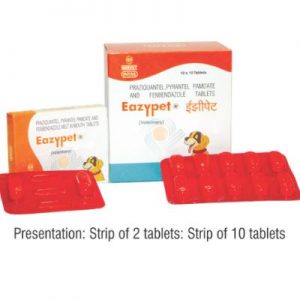Tramvetol 50 mg Tablets
Tramvetol 50 mg Tablets contain tramadol a synthetic opioid analgesic. It helps in pain management due to different ailments/ conditions in dogs.
Description
Tramvetol 50 mg Tablets
Tramadol 50 mg tablets for dogs
Manufactured/Marketed by: Virbac AH
Dosage form: Tablets
Tablets with brown dots and a break line on one side, which are flat, with rounded edges, and a distinct meaty smell.
Tablets can easily split into two equal halves.
Presentation:
White PVC/PE/PVDC – aluminium blister.
Box of 3 blisters of 10 tablets
Box of 10 blisters of 10 tablets
Not all pack sizes may be marketed.
Ingredients & Composition:
One tablet contains:
Active substance(s):
Tramadol (as hydrochloride) 43.9 mg
Equivalent to 50 mg of tramadol hydrochloride
Excipients:
Cellulose, microcrystalline
Starch, pregelatinized
Saccharin sodium
Meat flavour
Silica, colloidal anhydrous
Magnesium stearate
Description / Action:
Tramvetol 50 mg Tablets contain tramadol a synthetic opioid analgesic. It helps in pain management due to different ailments/ conditions in dogs.
Pharmacodynamic properties:
Tramadol is a centrally acting analgesic. The two enantiomers of tramadol and its major metabolite exhibit a complicated mode of action on opioid, norepinephrine, and serotonin receptors. The (+) enantiomer of tramadol has a low affinity for the μ-opioid receptors, inhibits serotonin uptake and enhances its release. The (-) enantiomer preferentially inhibits norepinephrine reuptake. Greater affinity for μ -opioid receptors is shown by the metabolite O-desmethyl-tramadol (M1). Contrary to morphine, tramadol does not suppress respiration for a wide analgesic dose range.
Likewise, it does not affect gastrointestinal motility. Mild effects are seen on the cardiovascular system. The analgesic potency of tramadol ranges between 1/10 to 1/6 in comparison to morphine.
Pharmacokinetic particulars:
Tramadol is well absorbed; peak plasma concentrations of 65 ng tramadol per mL are reached in 45 minutes following a single oral dosage of 4.4 mg tramadol HCL per kg bodyweight. The drug’s absorption is not considerably impacted by food.
By means of cytochrome P450-mediated demethylation and conjugation with glucuronic acid, tramadol is broken down in the liver. Compared to humans, dogs produce less of the active metabolite O-desmethyl-tramadol. Elimination occurs mainly via the kidneys with an elimination half-life of about 0.5-2 hours.
Class: Synthetic Opioid Analgesic
Indication / Uses:
Indicated in dogs for reduction of acute and chronic mild soft tissue and musculoskeletal pain.
Dosage and administration:
Tramadol hydrochloride is prescribed in doses of 2-4 mg per kg of body weight every eight hours, or as required depending on the severity of the pain.
The minimum dosing interval is 6 hours. The recommended maximum daily dose of tramadol is 16 mg/kg. As the individual response to tramadol is variable and depends partly on the dosage, the age of the patient, individual differences in pain sensitivity and general condition, the optimal dosing regimen should be individually tailored using the above dose and re-treatment interval ranges. A veterinarian should frequently evaluate the dog to determine whether additional analgesia is necessary. The daily dose of tramadol can be increased until the maximum daily dose is reached, or a multimodal analgesic strategy with the inclusion of other acceptable analgesics can be used to provide additional analgesia.
Please take note that the medication should only be administered at the maximum recommended dose of 4 mg/kg body weight using this dosing chart as a guide. It lists how many pills are needed to give 4 mg of tramadol hydrochloride for every kilogram of body weight.
Tramvetol 50 mg Tramadol Dosage by Body weight for Dogs
Bodyweight (kg) No. of Tablets
<6.25 kg NA
6.25 kg ½
12.5 kg 1
18.75 kg 1+1/2
25 kg 2
31.25 kg 2+1/2
37.25 kg 3
50 kg 4
62.5 kg 5
To ensure precise dosing, tablets can be divided into two equal portions. Take the tablet and press down with your thumbs on both sides on the scored side that is facing up to divide it.
For oral use in Dogs weighing more than 6.25 kg.
Contraindications:
Don’t use with monoamine oxidase inhibitors, serotonin reuptake inhibitors, or tricyclic antidepressants. Do not use in cases of known hypersensitivity to tramadol or any of the excipients.
Do not use in animals with epilepsy.
Special warnings for each target species:
Tramadol hydrochloride may have varying analgesic effects. This is attributed to individual variations in how the medication is metabolised to the main active metabolite, O-desmethyl tramadol. In some dogs (non-responders), the product might not be able to relieve pain. Multimodal analgesia should be taken into account for chronic pain. A veterinarian should periodically check on dogs to make sure they are receiving enough pain relief. The analgesic treatment may need to be reevaluated in the event of pain recurrence or insufficient analgesia.
Special precautions for use:
Special precautions for use in animals
In dogs with renal or hepatic impairment, use with caution. Tramadol’s ability to break down into its active metabolites in dogs with hepatic impairment may be reduced, which could lower the product’s effectiveness. Since one of tramadol’s active metabolites is eliminated through the kidneys, the dosage schedule may need to be changed in canines with renal impairment. When taking this medicine, renal and hepatic function should be kept under observation. If possible, long-term analgesic medication should be stopped gradually.
The person giving the veterinary medicine to the animals must take special measures. With unintentional intake especially by youngsters, it might result in drowsiness, nausea, and dizziness. Unused tablet components should be placed back into the open blister space, inserted into the carton, and stored in a secure location out of the sight and access of minors in order to prevent accidental ingestion, especially by a kid.
Seek urgent medical attention if you have accidentally ingested, especially if it’s a child, and be sure to show the package leaflet or label to physician. DO NOT DRIVE if you are an adult who has accidentally consumed tramadol as it may cause drowsiness or sedation.
Contact with this medication should be avoided by anyone who has a documented tramadol hypersensitivity or sensitivity to any of the excipients listed.
Wash hands after use.
Adverse reactions (frequency and seriousness)
Common side effects include mild sedation and drowsiness, particularly when higher doses are administered.
Rarely dogs have experienced nausea and vomiting after receiving tramadol.
In rare cases hypersensitivity can occur. When there is a hypersensitivity response, the medication should be stopped immediately.
Interaction with other medicinal products:
When this drug is taken with other central nervous system depressants, the effects of C.N.S. and respiratory depressants may be amplified.
This product can increase the effect of drugs that lower the seizure threshold. The analgesic efficacy of this product may be affected by medications that inhibit (e.g., cimetidine and erythromycin) or induce (e.g., carbamazepine) CYP450-mediated metabolism. Clinical relevance has not yet been thoroughly investigated for this interaction.
It is not advised to combine the product with mixed agonist/antagonists (such as buprenorphine or butorphanol), since the analgesic efficacy of a pure agonist may theoretically be diminished in such conditions.
Overdose (symptoms, emergency procedures, antidotes), if necessary
Tramadol overdoses are likely to cause symptoms similar to those seen with other centrally acting analgesics (opioids). These include in particular miosis, vomiting, cardiovascular collapse, consciousness disorders up to coma, convulsions and respiratory depression up to respiratory arrest.
General emergency measures: Maintain a patent airway, support cardiac and respiratory function depending on the symptoms. Inducing vomiting in order to empty the stomach is suitable unless the affected animal is showing reduced consciousness, in which case gastric lavage may be considered. The antidote for respiratory depression is naloxone. However, naloxone may not be useful in all cases of tramadol overdose as it may only partially reverse some of the other effects of tramadol. In case of seizures, administer diazepam.
Pharmaceutical precautions / Instructions:
There are no unique storage requirements for this veterinary medication.
The veterinary pharmaceutical medicine has a two-year shelf life in its retail packaging.
Shelf life of divided tablets: 3 days
Waste materials resulting from any unused veterinary medications or medications should be disposed of in line with local regulations. Method of dispensation: Veterinary medicine product subject to prescription, a single copy non-repeatable receipt.
For veterinary use. Not for human use.
Safety: Age / Pregnancy/ Withdrawal:
Pregnancy:
Tramadol was used in laboratory tests on mice, rats, and/or rabbits, but none of the animals tested revealed any teratogenic, foetotoxic, or maternotoxic effects. Usage only as determined by the competent veterinarian’s benefit-risk analysis.
Lactation:
Tramadol usage in laboratory research on mice, rats, and/or rabbits did not have any adverse impacts on offspring throughout the perinatal or postnatal periods. Usage only as determined by the competent veterinarian’s benefit-risk analysis.
Fertility:
Tramadol usage at therapeutic levels did not result in the manifestation of negative responses on reproductive parameters and fertility in the male and female in laboratory investigations using mice, rats, and/or rabbits, respectively.
Withdrawal period(s)
Not applicable.
Substitute: Ultrafix-T Tablets, Pet Paltra Tramadol Oral Solution, Trolgesic Tablets,
Click Here To Read More About Tramadol Uses in Dogs and Cats
Only logged in customers who have purchased this product may leave a review.







Reviews
There are no reviews yet.